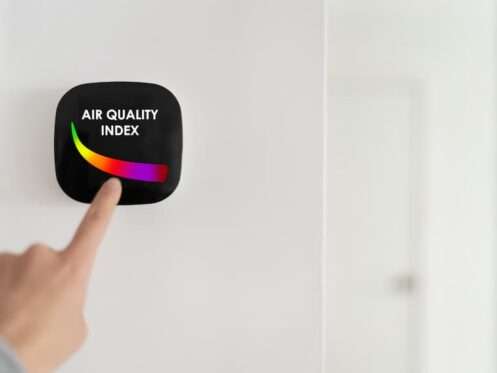Indoor air quality (IAQ) is a big part of maintaining a healthy and comfortable home environment, especially in smoggy Southern California. Poor IAQ can lead to allergies and respiratory issues, affecting your family’s well-being. Check out this homeowner’s guide to indoor air quality, giving you all the information on what it is, why it matters, and how to improve indoor air quality within your walls.
What is Indoor Air Quality (IAQ)?
Indoor air quality (IAQ) is the term used to judge the air you breathe at home and its impact on your family’s health and comfort. Clean, fresh air is an essential part of life, especially for those with allergies or respiratory issues, so it’s natural to want higher IAQ for your home. Poor IAQ can affect energy levels, sleep, and overall well-being, generally making you and your house worse off. Homeowners need to maintain their IAQ to ensure a safe and comfortable environment, shielding their family from harmful pollutants and making their home a more pleasant place to live.
Common Indoor Pollutants in SoCal Homes
Southern California homes often contend with specific indoor air pollutants that can affect air quality. Dust and allergens are common culprits, often entering through open windows and doors or being stirred up during daily activities. Volatile organic compounds (VOCs), which are emitted from a variety of household products such as paints, varnishes, and cleaning supplies, can degrade air quality and pose health risks. Another significant concern is wildfire smoke particulates, which can infiltrate homes during wildfire season, contributing to respiratory issues and other health problems.
The Role of Filtration in IAQ
Effective air filtration is one of the best ways to maintain good indoor air quality. The Minimum Efficiency Reporting Value (MERV) rating helps determine a filter’s effectiveness, with ratings from 1 to 20. Filters rated between 8 and 13 are typically recommended for homes, as they capture common pollutants like dust and pollen without restricting airflow too much. Using high-quality filters for HVAC purification can significantly improve air quality and protect your family from airborne contaminants.
Effective IAQ Solutions
Sano Heating & Air Conditioning provides various solutions to address indoor air quality issues. High-MERV filters are a great starting point, but UV light purifiers can also help by targeting bacteria and viruses. Whole-home air purifiers, humidifiers, and dehumidifiers maintain ideal humidity levels, preventing mold and reducing allergens. Regular duct cleaning ensures your HVAC system runs efficiently, free from dust buildup. Together, these solutions enhance the air you breathe, making for a healthier home environment.
Simple Tips to Improve IAQ
Improving indoor air quality can be straightforward. Regularly changing HVAC filters keeps your system efficient and effective at filtering pollutants. Vacuuming often, especially with a HEPA filter, reduces dust and allergens. Indoor plants can also improve air quality by naturally filtering toxins.
You’ll also want to make sure your home’s ventilation is adequate, allowing fresh air to circulate and dilute indoor pollutants. On days when outdoor air quality is good, open windows and doors to let in clean air. You could also consider using exhaust fans in kitchens and bathrooms to remove moisture and odors. Avoid smoking indoors, as tobacco smoke is a significant indoor pollutant. Be mindful of the cleaning products you use, opting for those with low VOC emissions.
Improve Your IAQ for a Healthier Home
Good indoor air quality ensures your family’s health and comfort. By understanding common pollutants in Southern California homes and using effective filtration and purification methods, you can create a safer, more enjoyable living space. Simple habits like changing filters and vacuuming support these efforts. For professional help and customized solutions, reach out to us at Sano Heating & Air Conditioning today. Our expertise is the perfect partner to help you achieve optimal air quality in your home.
Image credit // Shutterstock // Maridav







